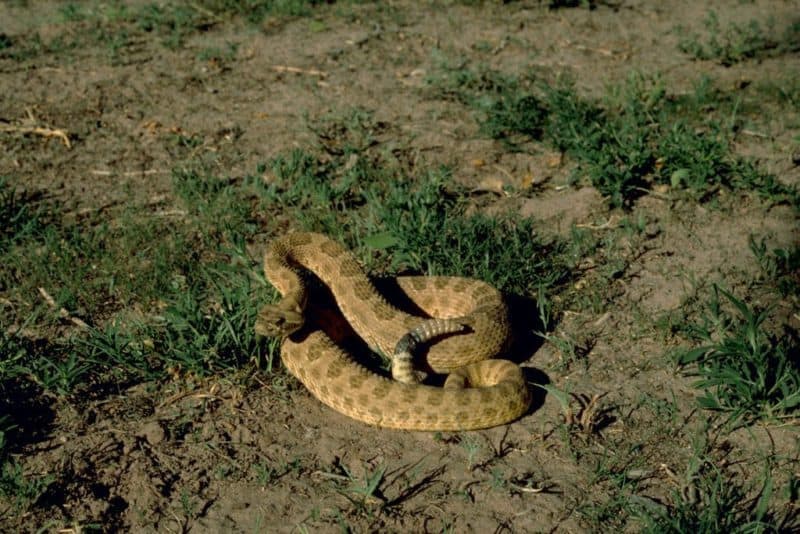There are venomous snakes in Montana. However, the state only has one venomous species. That is the Prairie Rattlesnake (Crotalus viridis).
Prairie Rattlesnakes are the most widespread rattlesnake species in North America. They’re also widespread in Montana, inhabiting all but the state’s northwestern corner.
Despite their menacing reputation, Prairie Rattlesnakes play an important role in the environment of the Big Sky state by keeping rodent populations in check.
They can be dangerous to humans, though. In fact, in an average year, around 38 people are bitten by Prairie Rattlesnakes in Montana. Learning about these dangerous reptiles’ appearance, behavior, and habitats can help you navigate Montana’s outdoors safely.
In this guide, you’ll learn how to recognize these snakes, their behaviors, and their habitats across Montana. We’ll also tell you how to co-exist with them as safely as possible.
Pit Vipers: The Venomous Masters of Infrared Detection
Like all Rattlesnakes, Copperheads, and Cottonmouths, Montana’s Prairie Rattlesnakes are among the members of the Crotalinae subfamily of the Viperidae family of venomous snakes, also referred to as pit vipers. These snakes are equipped with unique adaptations that make them exceptional hunters.
What Makes Pit Vipers Unique?
- Infrared-Sensing Pits:
A defining feature of pit vipers is the deep facial pit between their nostril and the eye on each side of their head. These specialized infrared-detecting organs allow pit vipers to sense heat emitted by prey. This adaptation enables them to:- Detect body heat from up to 1 meter away.
- Strike prey with pinpoint accuracy, even in complete darkness.
- Triangular Heads and Vertical Pupils:
- Head Shape: Pit vipers are recognized by their distinct triangular-shaped heads, which house their venom glands.
- Eyes: They have vertical elliptical-shaped pupils.
- Venomous Fangs:
Pit vipers have hollow fangs connected to venom glands. These fangs fold back against the roof of their mouth when not in use.
Ecological Importance
Pit vipers serve as a check to rodent populations. Despite their fearsome reputation, these snakes are vital to the health of many habitats.
Rattlesnakes
What Montana prairie rattlesnakes have in common with most other rattlesnake species is their rattle.
- Most rattlesnakes have a rattle at the end of their tail, comprised of hollow, loosely interlocked keratinous scales.
- Normally, a rattlesnake adds a new segment to its rattle each time it sheds its skin.
- An agitated rattlesnake rapidly vibrates its tail, causing the segments of its rattle to vibrate together, creating a rattling or buzzing sound.
- Not all rattlesnakes rattle before they strike. Sometimes, they lose their rattles due to injury, and sometimes, they choose not to rattle.
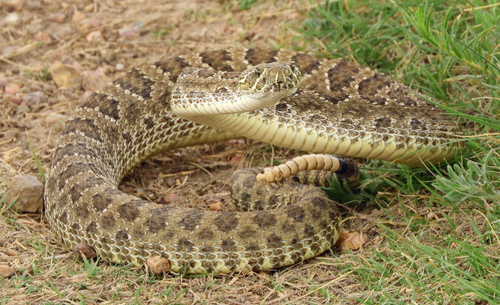
Prairie Rattlesnake (Crotalus viridis)
What Do Prairie Rattlesnakes Look Like?
| Size | *Adults typically measure about 3.3 feet (100 cm) in length. *The longest recorded specimen was just under 5 feet (151.5 cm) long. |
| Coloration | *Their base color varies and can be tan, olive green, or brown. |
| Dorsal Spots | *Brown blotches with darker borders are present on their bodies. |
| Head | *They have a triangular-shaped head with pit sensory organs on either side. *A light stripe runs diagonally from the back of each eye to the jaw. *Another stripe extends diagonally from below the eye to the corner of the mouth |
| Behavior | *Primarily ground-dwelling but occasionally climbs shrubs, bushes, or trees. |
| Conservation Status | They are common in Montana. |
Prairie Rattlesnake Lookalikes
The Gopher Snake and the Plains Hog-Nosed Snake have color patterns similar to those of a Prairie Rattlesnake. The Gopher Snake is non-venomous. On the other hand, the Plains Hog-Nosed Snake is mildly venomous but no threat to humans.
Where are Prairie Rattlesnakes Found in Montana?
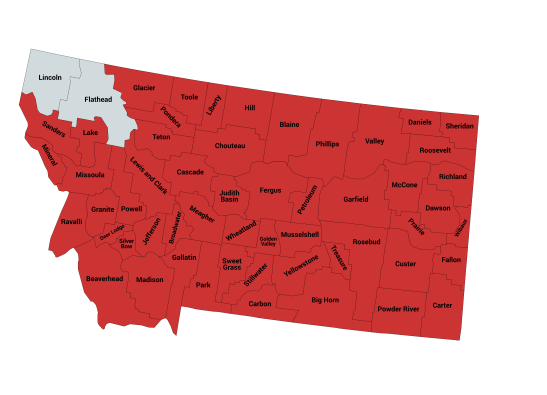
The Prairie Rattlesnake is found in almost all of the state. An exception is north-western Montana. They favor the open and arid country but can also be found in pine and grassy forests. You are most likely to run into them in areas where they can sun themselves. These include rocky areas with southern exposures or south-facing slopes with rocky outcrops. Even though they den in large groups, they will range up to seven miles from their den in the summer months. They are primarily ground snakes. However, they occasionally climb into shrubs, bushes, or trees.
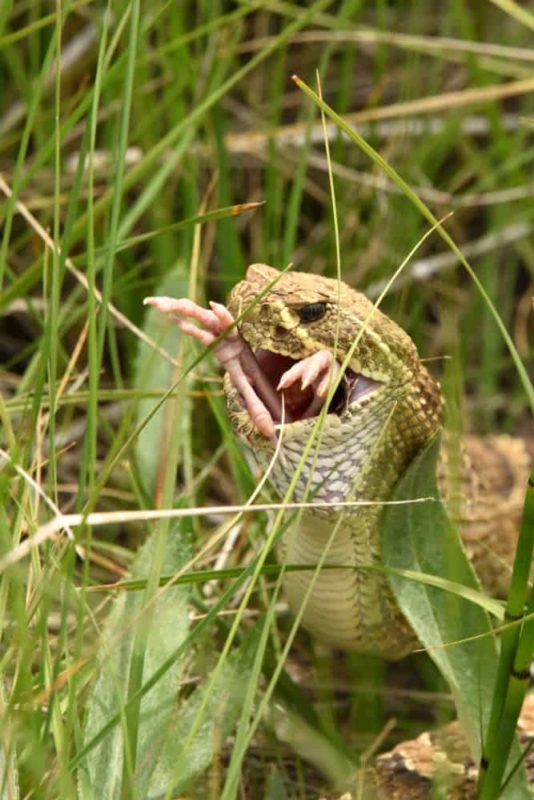
What Do Prairie Rattlesnakes Eat?
The Prairie Rattlesnake has a wide variety of prey because of its extensive range. They prefer small mammals. These include ground squirrels, mice, rabbits, prairie dogs, and rats. They will also dine on ground-nesting birds, amphibians, reptiles, and other snakes.
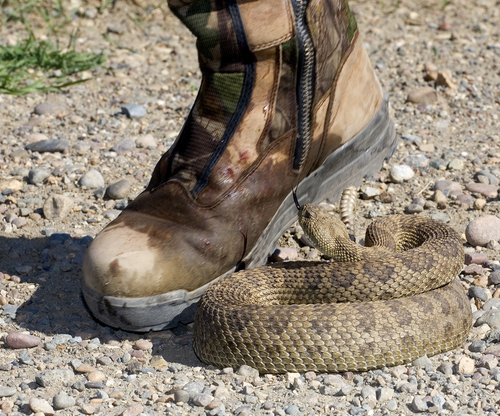
How Dangerous Are Prairie Rattlesnakes?
Prairie rattlesnake venom is a mix of hemotoxins and myotoxins. Furthermore, according to some literature, it also has neurotoxins.
Prairie rattlesnake bites can have profound effects. The venom can cause intense pain. It may also induce shock, making the victim feel weak and disoriented. Swelling, blistering, and inflammation can occur at the bite site. Their venom can also damage red blood cells and impair blood clotting. In severe cases, the bite may result in severe tissue damage. There is also a risk of harm to internal organs.
In 2006, a Roundup Montana man was killed by a bite from a prairie rattlesnake.
Montana’s Prairie Rattlesnakes in Winter: Insights into Brumation
During winter, Montana’s snakes, like all reptiles, enter a dormant state called brumation—a hibernation-like period. Because snakes are ectothermic (cold-blooded) and cannot regulate their body temperature internally, they slow their metabolism and become inactive during the colder months.
Brumation Habits
- Solo vs. Communal Brumation: Some snakes brumate alone, while others gather in communal dens. Prairie Rattlesnakes tend to brumate in communal dens, which they return to year after year.
Regional Variations
- Snakes may only seek shelter in warmer areas on the coldest winter days. They might not enter full brumation due to milder conditions.
Where Snakes Spend Winter
Snakes seek out protected spots to brumate, such as:
- Rock crevices
- Hollow logs
- Fissures on rocky hillsides
- They often choose south-facing slopes for den sites because these areas receive more sunlight, providing additional warmth during winter.
This natural adaptation allows Montana’s Prairie Rattlesnakes to survive the winter and re-emerge when temperatures rise.
Be Cautious in Montana’s Rattlesnake Country
The first thing people think about with regard to Rattlesnakes is the buzzing or rattling-type sound they make when they’re disturbed. However, sometimes, rattlers strike without rattling. You must be aware of where you are placing your hands and feet in rattlesnake country. If you hear a rattling noise, do not move until you spot its source. Otherwise, you may accidentally move into the snake, provoking it to strike you.
Be especially careful in areas where you have to use your hands to climb. Also, be alert in areas with thick brush or tall grass. You can use a long hiking stick to tap the ground in front of you. It might give an advance warning of a snake in your path and keep you at a safe distance.
It’s common sense to keep your dog on a leash in areas where rattlesnakes are common. Hunting dogs should have snake armor. Any snakebit dog should receive immediate veterinary care.
Snake encounters can sneak up on you suddenly if you’re not paying attention.
Here is an account from Montana’s Paradise Valley. Two teenage hikers happened upon a hillside covered with rattlers. They were concentrating on finding a spot with good phone reception. In the process, they didn’t notice the snakes at first.
Dressing For Rattlesnake Country
- High-top leather boots and long pants are both wise ideas.
- Also, wear loose-fitting denim to protect your lower legs. If there’s a gap before the snake’s fangs touch your skin, your chances of being envenomated are lower.
- In the absence of high-top leather boots, some people wear snake gaiters.
Symptoms of Venomous Snake Bites
Some of the symptoms you may experience when a venomous snake bites you include:
- Discoloration in the area of the bite.
- Swelling in the area of the bite.
- Loss of muscle coordination.
- Tingling sensation in the area of the bite.
- Feeling nauseous.
- Having a faster heart rate or rapid pulse.
- Difficulty breathing
What Should You Do if You Are Bitten?
If you or someone you are with has suffered a venomous snakebite, time is of the essence. Because the sooner a victim receives antivenom, the less chance the venom in their body has to cause harm. In other words, it is essential to seek immediate medical treatment.
Do not attempt to kill the snake for identification purposes. This gives the snake a chance to bite you again. Also, consider that severed snakeheads can still bite and envenomate and often do. If you have a cell phone, take a picture of the offending reptile. Otherwise, get started on your way to the nearest hospital.
First Aid for Snake Bite Victims
- Remain calm and limit your movements. Do not run. If you must hike back to a vehicle, do it calmly and deliberately. Put as little stress on your heart as possible.
- Keep the area of the snake bite below the heart level and never above the heart level. Keeping the bite below the heart level will reduce the venom’s flow. However, holding the bite above your heart level will increase the venom’s flow.
- Remove all constricting items such as bracelets, watches, or rings before swelling occurs.
- Remember that using a cold compress on a venomous snake bite is not advisable. The cold may cause the local blood vessels to constrict and spread the venom faster.
- You can wash the affected area like any other wound with soap and water.
- You may cover the bite area with a moist dressing to reduce the swelling.
- Get medical attention as soon as possible. Call the emergency room to tell them a venomous snake has bitten you so, they can have antivenom ready to give you when you arrive.
- A person whom a venomous snake has bitten may go into shock. If this happens, lay them flat and cover them with a blanket.
Conclusion
Montana’s Prairie Rattlesnakes are fascinating yet formidable creatures that play a vital role in the ecosystem. Their ecological importance stems from their ability to control rodent populations. But their venomous bite demands that people use caution in their habitats. By understanding their behavior and habitat and identifying characteristics, outdoor enthusiasts can navigate Montana’s rattlesnake country more safely.
Taking precautions—such as wearing protective clothing, keeping pets on leashes, and being mindful of your surroundings—can help reduce the risk from these snakes. In the rare event of a snakebite, staying calm, administering proper first aid, and seeking immediate medical attention are essential for minimizing harm.
With knowledge and vigilance, coexisting with Prairie Rattlesnakes can be a safe and enriching aspect of experiencing Montana’s outdoors.
You might also like:
Scorpions in Montana – Krebs Creek
Wild Cats in Montana – Krebs Creek
14 of the Most Dangerous Animals in Montana – Krebs Creek
Recent Posts
The only venomous snakes in Washington State are Northern Pacific Rattlesnakes. The Northern Pacific Rattlesnake (Crotalus oreganus oreganus) is a sub-species of the Western Rattlesnake. Anyone...
Skunks are not classified as true hibernators. But they go into a state of torpor when the weather gets cold. Skunks are light sleep hibernators, along with opossums, bears, and raccoons. ...

